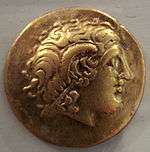Lemovices
The Lemovices or Lemovici (Gaulish: "those who vanquish by the elm")[1] were a Gallic tribe, dwelling in the modern Limousin region.
Name
They are mentioned as Lemovices by Caesar (mid-1st c. BC) and Pliny (1st c. AD),[2][3] as Lemoouíkes (Λεμοουίκες) by Strabo (early 1st c. AD),[4] and as Limouikoí (Λιμουικοί) by Ptolemy (2nd c. AD).[5][6]
The name Lemovices means 'those who vanquish by the elm' (probably the wood from which were made their lances or bows), stemming from Gaulish lemo- ('elm') attached to the suffix -uices ('victors').[1][7] The Gaulish root lemo- derives from Proto-Celtic *lēmo- or *limo- (compare with Old Irish lem, Middle Welsh liwyfen 'elm'), ultimately from Proto-Indo-European *h₁élem or *h₁leym- ('elm'; compare with Latin ulmus 'elm', Old Norse almr 'elm, bow', or Russian il'm 'mountain elm').[1][7]
The city of Limoges, attested as civitas Lemovicum ca. 400 CE ('civitas of the Lemovices', Lemovicas in 844, Lemotges in 1208), and the Limousin region, attested as Lemovicinum in the 6th c. CE (pago Lemovicino in 860, Lemozi in 1071–1127), are named after the Gallic tribe.[8]
History
They established themselves in Limousin and Poitou between 700 and 400 BC.
In 52 BC, some 10,000 Lemovician combatants fought against Julius Caesar at the Battle of Alesia as allies to the Arverni under Vercingetorix.[9] Their chief, Sedullos, was killed during the battle.[10]
Geography
Settlements
Their capital was originally Durotincum (Villejoubert). After their incorporation into the Roman province of Aquitania, Augustoritum (Limoges) was the capital of the civitas Lemovicum.[10] In the 1st c. CE, it was administered by the vergobretus, and later by a duumviri.[10]
Briva Curretia (Brive; from Gaulish briua 'bridge'), Blatomago (Blond) and Carovicus (Château-Chervix) were known vici ('villages') within the Lemovices' territory.[11][10]
Other locations associated with them were Acitodunum (23-Ahun), Argentate (19-Argentat), Cassinomagus (16-Chassenon), Roncomagus (87-Rancon), Excingidiacum (19-Yssandon) et Uxellum (19-Ussel). One of their main sanctuaries was recently found in Tintignac including several unique objects in the world such as "carnyx".[12]
Economy
Their territory was a region rich in gold, tin and iron.[10]
Archaeologists during the latter part of the 19th century found gold mines in the Lemovices' settlement in Limousin, particularly in the south-western region of the Massif Central in west-central France.[13] This discovery allowed the identification of techniques and the chronology of the mining activity because the Lemovices did not mention their mining heritage and their gold.[13]
References
- Delamarre 2003, p. 199.
- Caesar. Commentarii de Bello Gallico, 7:4:6
- Pliny. Naturalis Historia, 4:109
- Strabo. Geōgraphiká, 4:2:2
- Ptolemy. Geōgraphikḕ Hyphḗgēsis, 2:7:9
- Falileyev 2010, p. entry 3219.
- Matasović 2009, p. 237.
- Nègre 1990, p. 154.
- Waldman, Carl; Mason, Catherine (2006). Encyclopedia of European Peoples. New York: Infobase Publishing. p. 484. ISBN 0816049645.
- Demarolle 2006.
- Nègre 1990, pp. 50, 141, 194.
- http://tintignac.wix.com/tintignac-naves#!english/c11e3 Official website of Tintignac-Naves
- Morteani, Giulio; Northover, Jeremy (2013). Prehistoric Gold in Europe: Mines, Metallurgy and Manufacture. Dordrecht: Kluwer Academic Publishers. p. 219. ISBN 9789048145003.
Bibliography
- Delamarre, Xavier (2003). Dictionnaire de la langue gauloise: Une approche linguistique du vieux-celtique continental (in French). Errance. ISBN 9782877723695.CS1 maint: ref=harv (link)
- Demarolle, Jeanne-Marie (2006). "Lemovices". Brill’s New Pauly.CS1 maint: ref=harv (link)
- Falileyev, Alexander (2010). Dictionary of Continental Celtic Place-names: A Celtic Companion to the Barrington Atlas of the Greek and Roman World. CMCS. ISBN 978-0955718236.
- Matasović, Ranko (2009). Etymological Dictionary of Proto-Celtic. Brill. ISBN 9789004173361.CS1 maint: ref=harv (link)
- Nègre, Ernest (1990). Toponymie générale de la France (in French). Librairie Droz. ISBN 978-2-600-02883-7.CS1 maint: ref=harv (link)
External links
- Who Was Who in Roman Times
- Lemovices at the Galician Wikipedia
